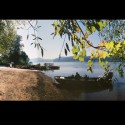Fostering Dialogue and Action for Environmental Recovery in Post-Industrial Pittsburgh
The 3 Rivers 2nd Nature project (2000-2005) sought to explore and expand the role of artists in promoting the ecological recovery of Allegheny County, Pennsylvania. Home to Pittsburgh and its surrounding areas, this post-industrial region faced numerous environmental challenges as it transitioned away from its steel industry legacy.
Artists as Catalysts for Change
Directed by artists/researchers Tim Collins and Reiko Goto, the project brought together artists, scientists, and community members to increase public attention and support for the health of the Allegheny, Monongahela, and Ohio Rivers. Central to this effort was the exploration of natural (green) infrastructure – a concept advocating for nature-based solutions to environmental problems.
Reimagining the Post-Industrial Public Realm
3 Rivers 2nd Nature stemmed from a larger body of work by Collins & Goto Studio examining the aesthetic and ethical dimensions of post-industrial landscapes. The project built upon their previous work on the Nine Mile Run Greenway Project, furthering their investigation into the meaning, form, and function of public space and nature in a region grappling with the remnants of its industrial past. This inquiry aligned with the broader discourse on post-industrial public space and the potential for art to act as a catalyst for social and ecological change.
Key Strategies and Outcomes:
- Interdisciplinary Research and Analysis: The project engaged in rigorous research, blending artistic practices with scientific expertise to analyze the region’s ecological conditions and identify opportunities for intervention. This research included mapping and documenting the rivers, their ecosystems, and the surrounding land use patterns.
- Public Discourse and Engagement: Recognizing the importance of community involvement, 3 Rivers 2nd Nature implemented several strategies to foster public dialogue and empower citizens to become active participants in the environmental recovery process:
- River Dialogues: These facilitated conversations brought together diverse stakeholders, including residents, policymakers, scientists, and artists, to discuss the challenges and possibilities for the three rivers.
- Monongahela Conferences: These conferences provided a platform for presenting research findings, sharing artistic perspectives, and engaging in broader discussions about the role of art, ecology, and planning in shaping the future of post-industrial regions.
- Groundworks Exhibition: This exhibition showcased the project’s research and artistic interventions, raising public awareness and stimulating conversations about the aesthetic and environmental potential of the region.
- Creative Advocacy and Policy Influence: 3 Rivers 2nd Nature went beyond research and dialogue, actively advocating for policy changes to support the project’s goals. One notable success was influencing zoning policies to afford greater protection to wooded areas and riparian zones, recognizing their ecological and aesthetic value.
A Lasting Legacy
While the 3 Rivers 2nd Nature project officially concluded in 2005, its impact continues to resonate. The project demonstrated the power of art to:
- Spark dialogue and bridge disciplinary divides.
- Reframe public perceptions of post-industrial landscapes.
- Empower communities to become active stewards of their environment.
The project’s legacy is evident in the tangible outcomes it helped to achieve, including the establishment of new public parks, strategic land acquisitions for conservation, and increased public awareness of the interconnectedness of art, ecology, and community well-being.
Exploring Further:
For a more in-depth understanding of the 3 Rivers 2nd Nature project, please visit the project website: 3r2n Project website.
